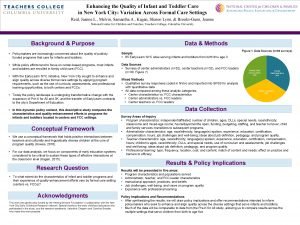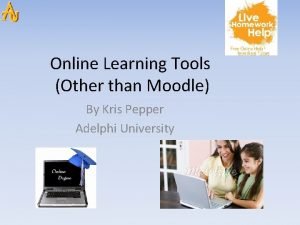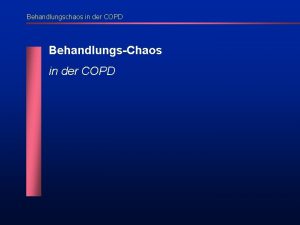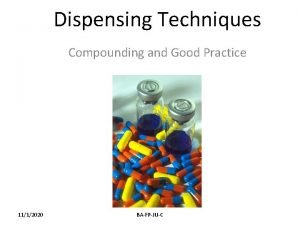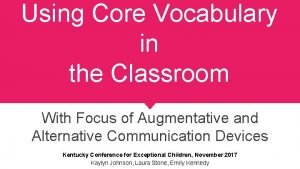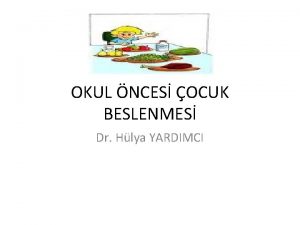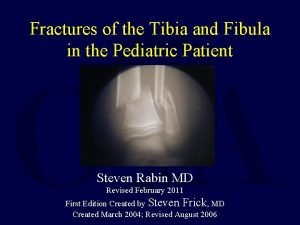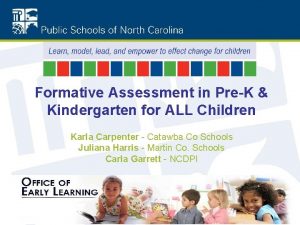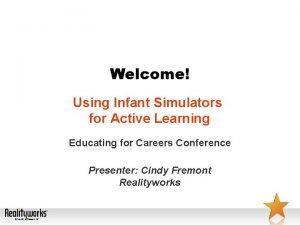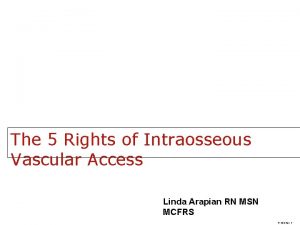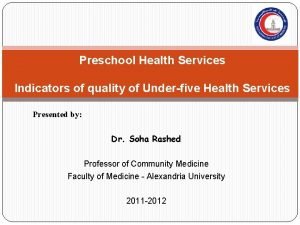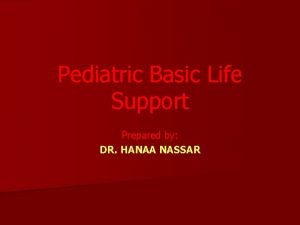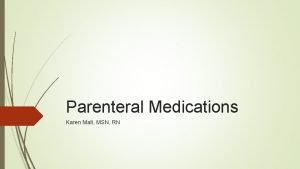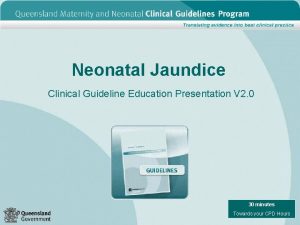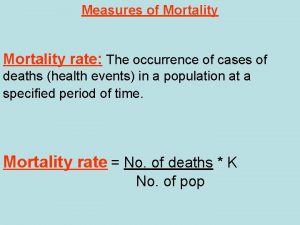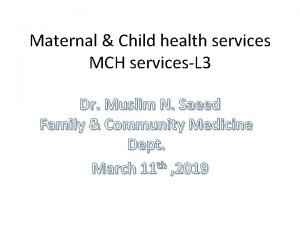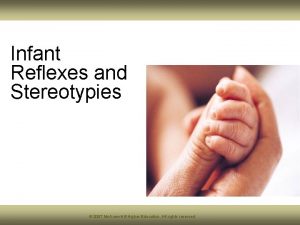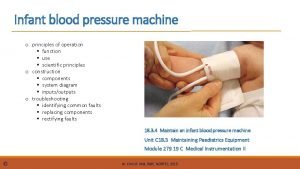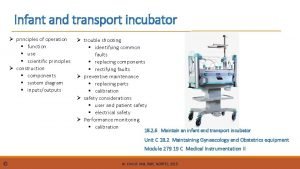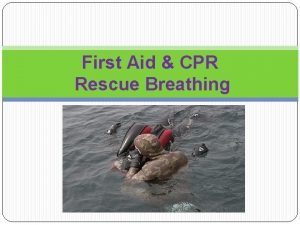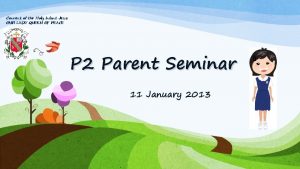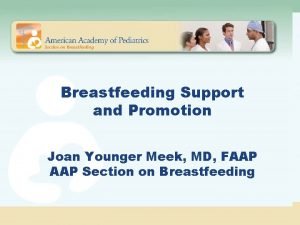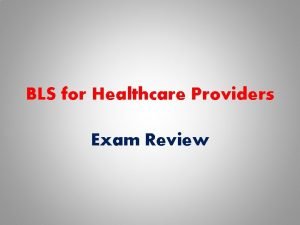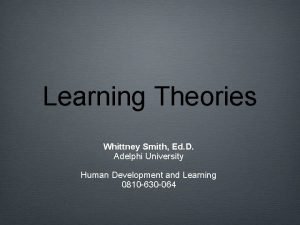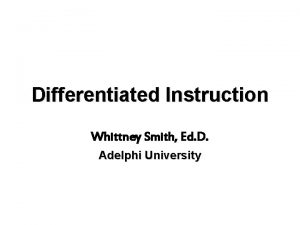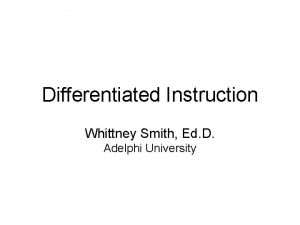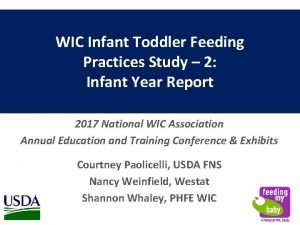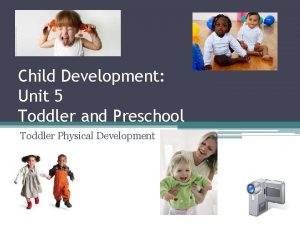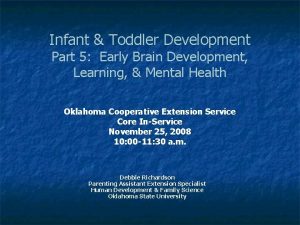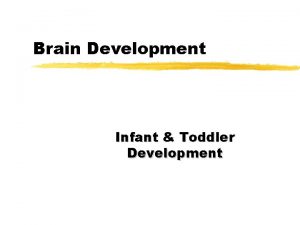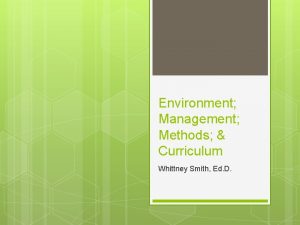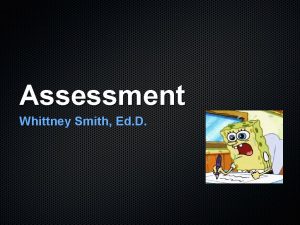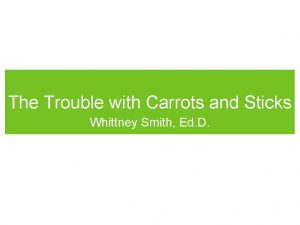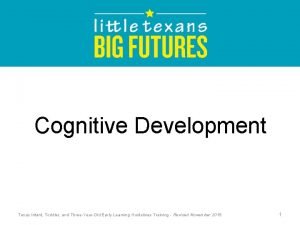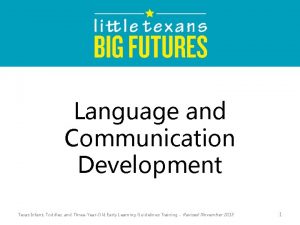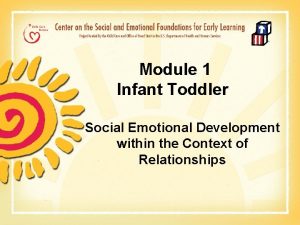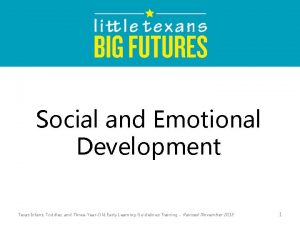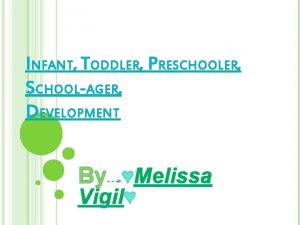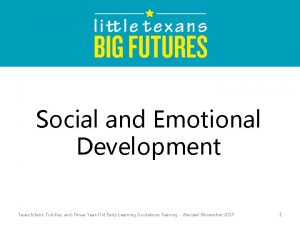Infant Toddler Development Whittney Smith Ed D Adelphi









































- Slides: 41

Infant & Toddler Development Whittney Smith, Ed. D. Adelphi University

Brain development starts early…. § Brain cells (neurons) form in first months of fetal development n n Born with 100 billion brain cells Enough brain cells to learn just about anything – no more are developed after birth 2

. . . In Utero

FUNCTIONS OF THE BRAIN Motor area Intellect, logic, reasoning Speech Hearing Sensory area Taste Language Vision Balance Emotional Regulation 3

The Brain. . . Self-regulation, Vision and perception problem solving, goal setting, social cognition Sensory motor perception, spatial abilities Hearing, language, memory, social emotional function

4

Myelination n Speed of connection Begins at birth, rapidly increases to 2 -years old Continues to increase more slowly through 30 years-old

Brain Connections n n n 15, 000 synaptic connections for each cell. Signals can be sent to other cells at speeds of more than 200 mph. Connections (synapses) grow and change as a result of stimulation from the environment. 5

Early Experiences are Crucial n n n Most brain cell connections are made in 1 st year. By age 3, 80% of synaptic connections are made. Connections decline after this time to age 10. During first 10 yrs. , brain is twice as active as adults. Then growth levels off & pruning begins. 6

Use it or Lose it n n n What is not used is pruned. What is used develops stronger connections. Develops in “spurts” when the brain is best equipped to learn certain skills. 7

Human Brain at Birth 6 Years Old 14 Years Old

5 Days 2 Months 1 Year 28 Years 9

Early Brain Development Nature & Nurture n n n Behavioral and brain development are interrelated. Interdependent factors: genetics, experience, relationships, health, and nutrition 60% of nutrition is used by the brain during the first year --- decreases to 30% by age 3. 10

Early Brain Development n n Quality of relationships and experiences in first 3 years has deep and lasting impact on how the brain gets “wired”. Sets foundation for development in every aspect of life. n Most developmental achievements occur naturally. n Progresses in a non-linear fashion. 11

Brain Development: Windows of Opportunity n By Age 2 – emotional control n By Age 2 – social attachment n By Age 5 – motor development n Birth to 10 years – language skills n Birth to 4 years – visual development n Birth to 4 years – math and logic skills n 3 to 10 years – music 13

14

Attachment Theory n Ainsworth, 1973; Bowlby, 1969 n n n Bowlby defined attachment as a “lasting psychological connectedness between human beings” provides an explanation of how the “parentchild” relationship emerges and influences subsequent development. Harlow’s Monkeys

Hierarchy of Brain Development FOREBRAIN Cortex “Executive Center” MIDBRAIN Limbic “Emotional Center” HINDBRAIN Cerebellum & Brainstem “Alarm Center” Abstract thought Concrete thought Logic/Reasoning Affiliation Attachment Contextual Memory Sexual Behavior Emotional Reactivity Arousal Appetite/Satiety Motor Regulation Blood Pressure Sleep Temperature Heart Rate 15 Breathing

Brain Hemispheres Left side --- positive emotions, language, approaching new situations or ideas. Right side --- negative emotions, intense emotions, creativity. Right hemisphere has growth spurt in first 1½ years, and is dominant for first 3 years. Early attachment experiences may impact development of the right brain. Healthy right brain activity supports mental health throughout lifespan. 16

Brain Hemispheres. . .

Deficits that occur in the early years may be overcome with later enrichment, though the process will likely be more difficult. Among the most important windows are those involving emotional and social development. Brain has plasticity and can recover time.

Two Basics the Developing Brain Needs n Safety n Positive Experiences 18

Early Negative Impact. . . …on brain growth, development and behavior during pregnancy, infancy or early childhood: n Inadequate nutrition n Drugs n Alcohol n Toxins (smoking, lead, chemicals) 19

A Dangerous Combination of Experiences n n Lack of critical early nurturing Chaotic and cognitively impoverished environments n Pervasive physical threat n Watching violence n Early, frequent, and intense stress 20

Deprivation n Brain activity of a normal 5 -year-old child (left) and a 5 -year-old institutionalized Romanian orphan who was neglected in infancy (right).

Stress & Development n n When stressed, brain releases the chemical Cortisol. High levels of Cortisol can slow brain development and child may experience more cognitive, motor, and social delays. 21

A Safe Environment for Brain Development § Reduce stress by making child’s world safe, secure and responsive. § Remove any physical threats. § Responsive to crying. § Predictable daily routines. n Adequate nutrition & hydration. 22

Positive Experiences for Building the Young Brain n n n Loving care & touch Consistent, individual attention Everyday, simple activities Exposure to new experiences Understanding of child development Talking n n n Music Limited television Balance – paying attention to the whole child Read and respond to child’s cues One size doesn’t fit all Know child & what he/she is capable of doing 23

Stimulation n Overstimulation may result in frustration, stress, or withdrawal. n Too many new experiences at once may be overwhelming and won’t help development. n Child needs time to process what he/she has learned. 24

Learning n n Children with a secure bond to caregivers are more ready to learn. Children learn by doing. Fancy, expensive toys, videos, and flash cards are not necessary. Repetition in a variety of ways – modeling, actions, verbally, etc. 25

Language n n Children exposed to lots of language in reading, singing, and talking develop more neuron connections in the brain area that handles language (temporal lobe). Children not involved in lots of verbal interaction have brains that are measurably less developed. 26


Thinking n n Exposure to lots of language is directly linked with advanced thinking skills. Toddlers understand can solve more difficult problems at a younger age than children in poor quality environments. 27

Physical Activity n n n Toddler brains thrive with the opportunity to climb, play, splash, and run. Exercise actually causes the parts of the brain that control movement to develop more neuron connections. For example, leaving a child in a playpen or in front of TV all day slows motor development. 28

Emotional Control n n Brain development helps determine a person’s emotional tendencies. Infants raised with inconsistent routines, changing caregivers, and stressful environments are more anxious, impulsive, may be less caring toward others, and have fewer problem-solving skills. 29

Crying n n Crying –communication of emotion; response to distress Colic (1 in 10 infants; birth – 12 weeks Extended periods of intense crying n n Cause unknown (Immature nervous system; Hyper-sensitivity; Digestive problems) Soothing Swaddling – tight wrapping of baby in cloth n Touch n Soft, rhythmic sounds n Vibration n

Crying Disorders n Prolonged crying exposes the brain to high levels of cortisol, adrenaline, and other damaging chemicals. n n n Damage to hippocampus (memory) Reduced levels of vasopressin and serotonin Reduced levels of emotional regulation Impaired memory Increased levels of aggression/violence/bullying Increased levels of anxiety disorders

Self Regulation n Strategies for adjusting emotional state to a comfortable (adaptive) level of intensity in order to accomplish goals n n Infants: withdrawal, distress, crying -- need soothing 4 months: shift focus of attention 1 year: approach/retreat from stimulus Parent response to distress is important n n Sympathetic - child more easily soothed, more selfregulated Non-responsive (wait to intervene) - child enters into rapid, intense distress; harder to sooth; doesn’t develop self-regulation

Self-Regulation Continued. . . n When an infant’s needs are met, they can focus on the world around them and explore. n n Their brains take in and adapt to stimulation from the external world. When they aren’t met, they become fixated on trying to get their needs met. n They stop exploring and shut other stimulation from the external world.

Infant/Early Childhood Mental Health • Synonymous with healthy social and emotional development. • Capacity to experience, regulate and express emotions. • Infant characteristics – biological influences, individual differences. • In various contexts within which caregiving takes place – social & cultural. • Focuses on unfolding infant-parent relationship. 30

What Science Tells Us ➡Early relationships have permanent effects on brain development, health, and later mental health. ➡Social-emotional and physical health are inseparable in the very early years. ➡Responsive caregiving can mediate the effects of some chronic health conditions, e. g. , prematurity, poverty. ➡Social and emotional development is strongly linked to success in school (and beyond). ➡Intervention can be effective; children and adults can recover. 31
 Drdp infant toddler essential view
Drdp infant toddler essential view Infant/toddler sensory profile score sheet
Infant/toddler sensory profile score sheet Brigance test for 4 year-old score
Brigance test for 4 year-old score Adelphi early learning center
Adelphi early learning center Adelphi moodle login
Adelphi moodle login Adelphi research steroids
Adelphi research steroids Degree works oberlin
Degree works oberlin Adelphi definition
Adelphi definition Dispensing techniques
Dispensing techniques Banajee list of toddler vocabulary
Banajee list of toddler vocabulary Antibiotics for uti in toddler
Antibiotics for uti in toddler Toddler dönemi nedir
Toddler dönemi nedir Site:slidetodoc.com
Site:slidetodoc.com Fever in toddler
Fever in toddler Malaguzzi quotes
Malaguzzi quotes Personality development in infants
Personality development in infants Cone of experience
Cone of experience Corruption
Corruption Hart plain infant school
Hart plain infant school Infant-industry argument
Infant-industry argument Infant io placement
Infant io placement Keeping an infant safe and well section 7-3
Keeping an infant safe and well section 7-3 Equation
Equation Chest compression ratio in newborn
Chest compression ratio in newborn Vastus lateralis injection site infant
Vastus lateralis injection site infant Nips scale
Nips scale Neonatal jaundice
Neonatal jaundice Death rate formula
Death rate formula Kenmore park infant and nursery school
Kenmore park infant and nursery school Primitive reflexes chart
Primitive reflexes chart What is habituation
What is habituation Juan soriano la niña muerta; the dead girl; dead infant
Juan soriano la niña muerta; the dead girl; dead infant Infant reflexes chart
Infant reflexes chart Infant blood pressure
Infant blood pressure Infant incubator working principle pdf
Infant incubator working principle pdf Botulism symptoms
Botulism symptoms What is llf in cpr
What is llf in cpr Convent of the holy infant jesus
Convent of the holy infant jesus Promoting infant health section 7-2
Promoting infant health section 7-2 Weight gain in infant
Weight gain in infant Compression to ventilation ratio adults
Compression to ventilation ratio adults Saguaro infant care and preschool
Saguaro infant care and preschool



